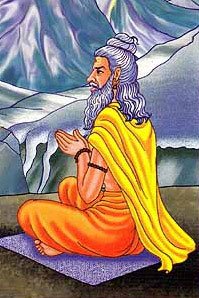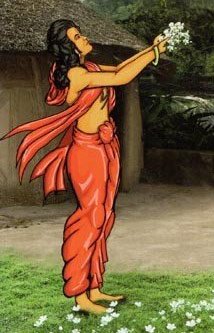Jamadagnya, Jāmadagnya: 11 definitions
Introduction:
Jamadagnya means something in Hinduism, Sanskrit. If you want to know the exact meaning, history, etymology or English translation of this term then check out the descriptions on this page. Add your comment or reference to a book if you want to contribute to this summary article.
In Hinduism
Purana and Itihasa (epic history)
Source: Cologne Digital Sanskrit Dictionaries: The Purana IndexJāmadagnya (जामदग्न्य).—A tīrtha on the Narmada. Here Indra became lord of gods.*
- * Matsya-purāṇa 194. 35-6.

The Purana (पुराण, purāṇas) refers to Sanskrit literature preserving ancient India’s vast cultural history, including historical legends, religious ceremonies, various arts and sciences. The eighteen mahapuranas total over 400,000 shlokas (metrical couplets) and date to at least several centuries BCE.
Pancaratra (worship of Nārāyaṇa)
Source: Shodhganga: Iconographical representations of Śiva (pancaratra)Jāmadagnya (जामदग्न्य) or Jāmadagnyasaṃhitā is the name of a Vaiṣṇava Āgama scripture, classified as a tāmasa type of the Muniprokta group of Pāñcarātra Āgamas. The vaiṣṇavāgamas represent one of the three classes of āgamas (traditionally communicated wisdom).—Texts of the Pāñcara Āgamas are divided in to two sects. It is believed that Lord Vāsudeva revealed the first group of texts which are called Divya and the next group is called Muniprokta which are further divided in to three viz. a. Sāttvika. b. Rājasa. c. Tāmasa (e.g., Jāmadagnya-saṃhitā).

Pancaratra (पाञ्चरात्र, pāñcarātra) represents a tradition of Hinduism where Narayana is revered and worshipped. Closeley related to Vaishnavism, the Pancaratra literature includes various Agamas and tantras incorporating many Vaishnava philosophies.
Kavya (poetry)
Source: academia.edu: Gleanings from Atula’s MusikavamsaJāmadagnya (जामदग्न्य) (=Jāmadagnyarāma) or Paraśurāma is the name of an ancient Sage, according to the historical poem Mūṣikavaṃśa by Atula dealing with the royal lineage of North Kerala in roughly 1000 verses.—The Mūṣikavaṃśa begins with an account of a pregnant queen, guarded by her family priest, escaping the animosity of sage Jāmadagnya Rāma, more popularly known as Paraśurāma (‘Rāma with axe’) in the West coast of India, reaching the mountain called Eli. The queen delivers a male child who was properly educated by her priest who becomes King Rāmaghaṭa.He appoints Mahānāvika, a merchant (śreṣṭhin) from māhiṣmatī as his minister and builds Kola, the capital city of the dynasty. Crossing the Killā river, he visits the mountain and seeks the blessing of Paraśurāma. [...]

Kavya (काव्य, kavya) refers to Sanskrit poetry, a popular ancient Indian tradition of literature. There have been many Sanskrit poets over the ages, hailing from ancient India and beyond. This topic includes mahakavya, or ‘epic poetry’ and natya, or ‘dramatic poetry’.
Languages of India and abroad
Sanskrit dictionary
Source: DDSA: The practical Sanskrit-English dictionaryJāmadagnya (जामदग्न्य).—Name of Paraśurāma q. v.; जामदग्न्यमपहाय गीयते तापसेषु चरितार्थमायुधम् (jāmadagnyamapahāya gīyate tāpaseṣu caritārthamāyudham) Kirātārjunīya 13.62.
Derivable forms: jāmadagnyaḥ (जामदग्न्यः).
Source: Cologne Digital Sanskrit Dictionaries: Shabda-Sagara Sanskrit-English DictionaryJāmadagnya (जामदग्न्य).—m.
(-gnyaḥ) A name of Parasurama. E. jamadagni a Muni so named and yañ patronymic affix; the son of the saint Jamadagni.
Source: Cologne Digital Sanskrit Dictionaries: Benfey Sanskrit-English DictionaryJāmadagnya (जामदग्न्य).—i. e. jamadagni + ya, I. adj. Referring to Jamadagni, Mahābhārata 1, 332. Ii. patron. A descendant of Jamadagni, [Rāmāyaṇa] 1, 74, 23.
Source: Cologne Digital Sanskrit Dictionaries: Cappeller Sanskrit-English DictionaryJāmadagnya (जामदग्न्य).—[adjective] the same.
Source: Cologne Digital Sanskrit Dictionaries: Monier-Williams Sanskrit-English Dictionary1) Jāmadagnya (जामदग्न्य):—[from jāmadagna] mfn. belonging or relating to Jamad-agni or to his son Jāmadagnya, [Mahābhārata i, 332; Harivaṃśa 2313; Rāmāyaṇa i, 75, 3]
2) [v.s. ...] m. ([gana] gargādi) = gniya, [Āśvalāyana-gṛhya-sūtra i, 7; Kātyāyana-śrauta-sūtra iii, 3, 12/13]
3) [v.s. ...] Rāma (Paraśu-), [Ṛgveda-anukramaṇikā; Mahābhārata iii, vii; Rāmāyaṇa i f.; Bhāgavata-purāṇa ix]
4) [v.s. ...] Name of a Catur-aha, [Maśaka vii, 5]
5) [v.s. ...] [plural] Jamad-agni’s descendants, [Pravara texts i.]
Source: Cologne Digital Sanskrit Dictionaries: Yates Sanskrit-English DictionaryJāmadagnya (जामदग्न्य):—(gnyaḥ) 1. m. Parashurāma.
[Sanskrit to German]
Sanskrit, also spelled संस्कृतम् (saṃskṛtam), is an ancient language of India commonly seen as the grandmother of the Indo-European language family (even English!). Closely allied with Prakrit and Pali, Sanskrit is more exhaustive in both grammar and terms and has the most extensive collection of literature in the world, greatly surpassing its sister-languages Greek and Latin.
See also (Relevant definitions)
Starts with: Jamadagnyadvadashi, Jamadagnyajaya, Jamadagnyaka, Jamadagnyarama, Jamadagnyasamhita, Jamadagnyay, Jamadagnyayita.
Full-text (+19): Jamadagnyadvadashi, Akritavrana, Jamadagna, Jamadagnyaka, Jamadagnyay, Shastragrahin, Jamadagniya, Parashurama, Dhanurveda, Pundarikavitthala, Shivaganga, Yuga, Jamadagnyasamhita, Kandaprishtha, Savanadurga, Eli, Lakshmidhara, Kanakeshvara, Madhavabhatta, Mahidharaiya.
Relevant text
Search found 32 books and stories containing Jamadagnya, Jāmadagnya; (plurals include: Jamadagnyas, Jāmadagnyas). You can also click to the full overview containing English textual excerpts. Below are direct links for the most relevant articles:
Sahitya-kaumudi by Baladeva Vidyabhushana (by Gaurapada Dāsa)
Text 5.13 < [Chapter 5 - Second-rate Poetry]
Hanuman Nataka (critical study) (by Nurima Yeasmin)
Hanuman-Nāṭaka, Act 14 (Summary) < [Chapter 3]
1. Rīti (Style) in the Haumannāṭaka < [Chapter 4]
2. Influence of other Poets upon Śrī Dāmodara Miśra < [Chapter 6]
The Skanda Purana (by G. V. Tagare)
Chapter 121 - Greatness of Jāmadagnyeśvara (Jāmadagnya-īśvara) < [Section 1 - Prabhāsa-kṣetra-māhātmya]
Chapter 115 - Gotras of Sages < [Section 1 - Tīrtha-māhātmya]
Chapter 29 - Rāmeśvara (rāma-īśvara-liṅga) < [Section 2 - Caturaśīti-liṅga-māhātmya]
Brahma Sutras (Shankaracharya) (by George Thibaut)
III, 3, 33 < [Third Adhyāya, Third Pāda]
Garga Samhita (English) (by Danavir Goswami)
Verse 8.13.63 < [Chapter 13 - A Thousand Names of Lord Balarāma]
Brihad Bhagavatamrita (commentary) (by Śrī Śrīmad Bhaktivedānta Nārāyana Gosvāmī Mahārāja)
Verse 2.4.155-157 < [Chapter 4 - Vaikuṇṭha (the spiritual world)]